|
| Mt.
Shosha |
 |
While
seeking a new spiritual place, Shoku, a holy Buddhist priest,
founded the Engyoji Temple on Mt. Shosha in the early Heian
Period (10th century). This temple is one of the three most
important training centers of the Tendai sect, and is called
the Mt. Hiei of The West. Many people visit this temple year-around,
and it is now known as a location spot for filming the movie “Last
Samurai” and the NHK drama series “Musashi”.
[ Large view ] |
| [ Top ] |
| Ropeway
- Panoramic View |
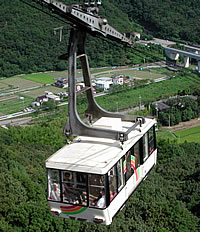 |
You
can take the ropeway or walk up to the top of the mountain
while enjoying the flora. From the top you have a panoramic
view of Himeji city and the Harimanada Sea.
[ Large
size ]- 
[ Large view ] 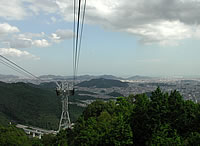 |
| [ Top ] |
| Kannon
Statues |
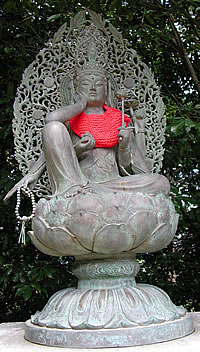 |
From
the ropeway terminal you can walk up the pathway while flanked
by Kannon statues of 33 pilgrimage sites. The clear and solemn
atmosphere is physically and spiritually refreshing.
[
Large view ]
[ Large view ] 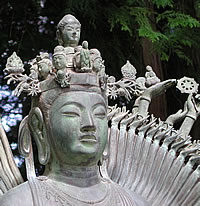 |
| [ Top ] |
| Niomon |
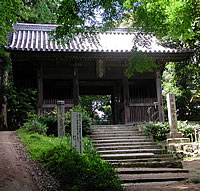 |
Soon
you will reach the Niomon, the main gate. The temple grounds
inside the gate are sacred. There were more than 30 sub-temples
on the mountain at its zenith, and emperors and aristocrats
once visited here. Many existing buildings and Buddhist statues
are appointed as cultural properties.
[ Large
image ] |
| [ Top ] |
| Juryoin |
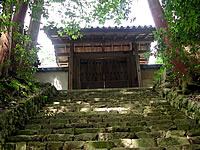 |
Juryoin
has the highest rank among the sub-temples, and records show
the former Emperor Goshirakawa visited there. Its outer appearance
is built in the traditional Shinnden style, but the inside
was designed in the Shoin style. You can enjoy a “Shojin
Dinner” with Shosha lacquer ware by appointment. |
| [ Top ] |
| Maniden |
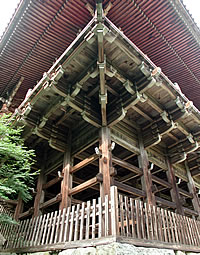 |
Coming
down the Gongen
slope and passing over the Yuya Brigde you are facing “Maniden”,
the main building. The magnificient structure of Maniden,
standing halfway up the rocky cliff, reminds visitors of
the Kiyomizu Temple in Kyoto. Year-around pilgrims visit
Maniden, the 27th location site of Western Japan pilgrimage.
[
Large view ]
[ Large view ] 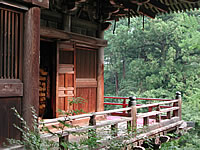 |
| [ Top ] |
| Mitsunodo
(Three Halls) |
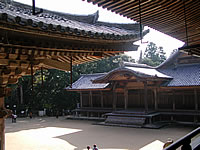 |
Leaving
Maniden and passing beneath big trees that are hundreds of
years old, you will come to a silent, open space surrounded
by three buildings. All three buildings were built in the
Muromachi period (15th century).
[ Large
view ] 
|
| |
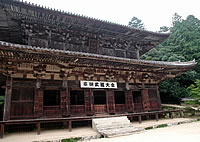
[ Large
view ] |
Daikodo
This great auditorium was constructed in 986
A.D. at the request of the retired Emperor Kazan, who named
this temple Engyoji at that time. Daikodo was famous
as a training center for priests. This building is
dedicated to the Incarnation of Truth. The present
building was dismantled and reconstructed in 1956.
[ Large view ]  |
| |
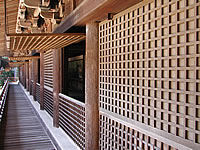
[ Large view ] |
Jikido
Jikido was constructed in 1174 at the request of the retired
Emperor Goshirakawa to enshrine the God of Wisdom and Intellect. 40m-wide,
two-storied building is unique for its architectural style.
It is said to have been both a priest's training center and
a boarding house.
[ Large view ] 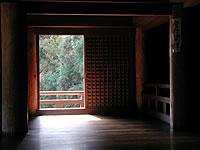 |
| |

[ Large view ] |
Jogyodo
This training hall is dedicated to Amitabha. Trainees
walk around Amitabha statue for days calling the holy name. Ceremonial
music and graceful dances were performed on the northern
stage of this building opposite the great auditorium. The
building was remodeled and reconstructed in 1965.
[ Large view ]  |
| [ Top ] |
| Honda
Family Graves |
 |
In
front of these three buildings are the graves of Honda’s
family, once a Lord of Himeji Castle. |
| [ Top ] |
| Okunoin |
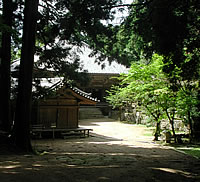 |
"Okunoin"
(inner sanctuary) is beyond the three buildings.
[ Large view ] |
| |
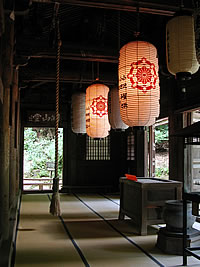
[ Large
view ] |
Kaizando
Shoku, founder of Engyoji Temple, is worshiped
at “Kaizando”. Formally there were Sumo wrestlers,
carved by Jingoro Hidari, sustaining the roof at the four
corners. But it is said that the wrestler at the northwest
corner ran away, incapable of sustaining the weight of the
roof.
[ Large view ]
 |
| |
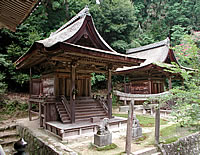 |
Gohodou
These two buildings, Gohodou, with thatched
roofs made of cypress bark, are dedicated to two deities,
Ototen and Wakaten. They served Shoku as guards and guides.
The Benkei Study is facing Gohodo. It is said
that Benkei had studied and trained at Mt. Shosha in his
youth, and many legends and related objects remain. |
| [ Top ] |
| Art
and Craft Museum |

[ Large view ]
|
After
spending a relaxing and calm time on Mt. Shosha, you are
welcome at the “Shosha-no-sato Art and Craft Center” at
the foot of the mountain. You will find artwork done by Kosho
Shimizu who was born in Himeji and became the chief priest
at the Todaiji Temple in Nara. You can observe or participate in making traditional Himeji crafts such as Himeji Hariko,
Himeji goma, leather products and Himeyama dolls. You will
observe professional skills like those demanded of young
priests after much training. |
| [ Top ] |

